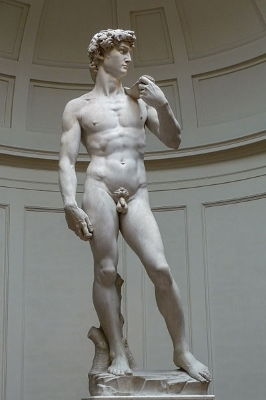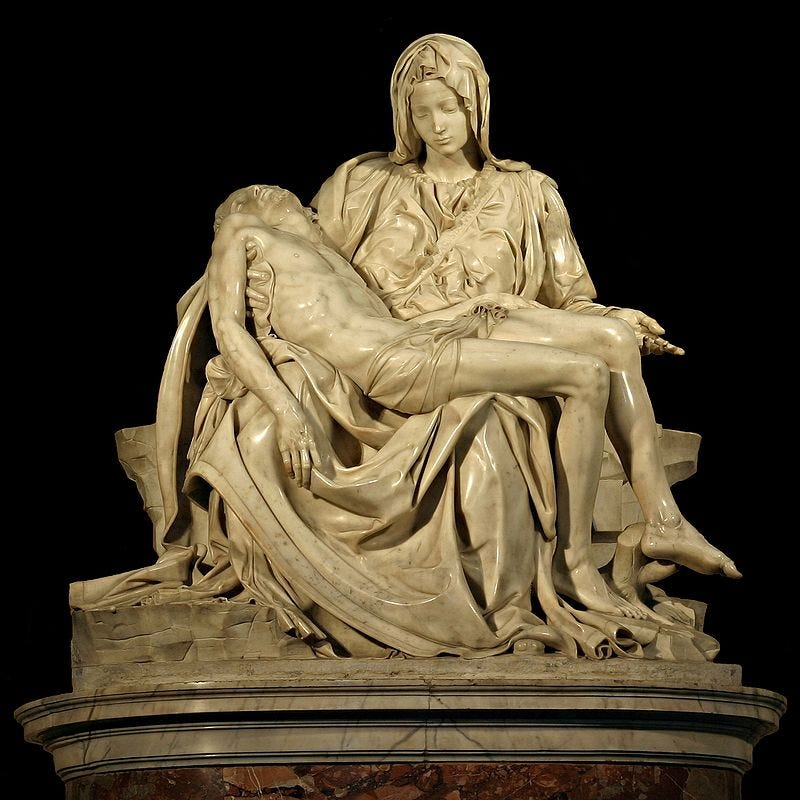History Short Answer 2 Spring 2025
1/30
There's no tags or description
Looks like no tags are added yet.
Name | Mastery | Learn | Test | Matching | Spaced |
|---|
No study sessions yet.
31 Terms
Which artist made David, a Pietá, and painted the Sistine Chapel. He was hailed as “divine” by Vasari. He was a sculpture, architect, painter, and poet. Pope Julius encouraged his ambitions.
Michelangelo

What piece is this? Made by Michelangelo in 1501 after he came back to Florence, which had reestablished it’s republican form of government. Directors of the works of the Florence Cathedral commissioned him to make it on one of the buttresses of the facade. Another sculptor previously started. It was completed in 1504, and put it in front of the Palazzo della Signoria, the seat of the Florence government.
David

Which piece is this? Made by Michelangelo, it has realistic drapery and poses are naturalistic. It was commissioned by French Cardinal Jean de Villiers de la Groslaye in 1498 for his tomb chapel near St. Peter’s, where it is now. Michelangelo promised to carve “the most beautiful work of marble in Rome”. It helped to establish Michelangelo’s reputation as a sculptor
The Pietà
Who were beginning to be seen as humanists during the Renaissance? This garnered them more respect. Before, they were seen as craftsmen/tradesmen, not held up to a high esteem.
Artists
A term for someone who is a great thinker or a sort of philosopher. They were held of high importance.
Humanist
During the High Renaissance, what era were artists drawing inspiration from?
Classical
What classical posing idea did High Renaissance artists use? It included an engaged/active leg and the free leg, and shoulders and hips were at opposing slants.
Contrapposto
How did Michelangelo explain why he depicted the Virgin Mary in The Pietá so young?
She was chaste, and she may have had divine assistance to appear pure and a virgin (this is unlike Jesus, since He was depicted to have taken on a total human form, thus He is at his own age)
How old was Michelangelo when he made The Pietá? He was given great fame since many felt his work was better than his contemporaries, and maybe contended with the ancients
24-25
How was Leonardo different than Michelangelo
Leonardo thought painting to be the nobelist form of art, whilst MIchelangelo thought this to be true of sculpting.
Who were artists that Michelangelo was inspired by?
Giotto, Masaccio, and Donatello
Since MIchelangelo came from the nobility, his parents initially didn’t want him to become an artist, however later he was apprenticed by whom?
Ghirlandaio
Who invited Michelangelo to study his antique statues in his garden?
Lorenzo de’ Medici
Who was the overseer of the Medici collections that helped to teach Michelangelo rudimentary sculpture. However, he prefered carving and marble and chisel, and only used clay as a way to sketch.
Bertoldo di Giovanni
Why did artists of the Renaissance look back to the classical period?
They were looking for the best in history
What era did people begin to see artists as humanists? They also used Sfumato, did portraits, and were inspired by ancient mythology.
The High Renaissance
What place’s cultural climate influenced Michelangelo during the 1480-1490’s? However, troubled times led him to flee during 1492 to first Balogna then for Rome.
Florance
What did this cause:
Lorenzo de' Medici's death in 1492 put an end to the intellectual atmosphere that he had fostered. The subsequent expulsion of the Medici, and the rise to power of the fiery preacher Girolamo Savonarola, brought calls for a spiritual awakening and a rejection of "paganism" and materialism. Both the Neo-Platonism of Marsilio Ficino and the religious reforms of Savonarola affected this person profoundly.
Michelangelo to flee during 1492 from Florence for Rome
What caused Michelangelo to do and feel like this?
Michelangelo made statues as human bodies released from their marble prisons. He thought this of bodies too. He felt they were the earthly prison of the soul-noble. This endows his figures with much pathos. They looked outwardly calm, but had an overwhelming psychic energy that finds no release in physical action.
The Neo-Platonism of Marsilio Ficino and the religious reforms of Savonarola
What influenced Michelangelo to depict figures very muscular, especially David? This later became a part of his art style and the overall style of the Renaissance. In David, instead of adding lots of emotion, David is calm and tense, active and static.
Hellenistic sculptures
New St. Peter’s commissioned this work in 1505, however it was interrupted by Julius before his death in 1513, leaving it incomplete. Hiers negotiated with Michelangelo for the next 30 years to make a reduced version of the original plan. It was meant to be a grand statement for glory to The Pope.
The Tomb of Julius II
What word that Vasari used did Moses have The Tomb of Julius II, similar to sublime? It would strike fear and power
Terribilita
In The Tomb of Julius II, what did Moses have? This was due to a mistranslation for the Hebrew word for “ray”. It was supposed to signify the divine favor bestowed upon him.
Horns
Unlike similar scenes made by other artists, Mary is calmer in Michelangelo’s Pietá, and the people of the scene seem to be in less distress, how come?
Michelangelo imagined the scene as a final farewell between Son and mother as a calm and transcending moment.
How does Michelangelo’s David differ from Donatello’s depiction?
Michelangelo treated the figure as not a victorious hero, but an ever-vigilant guardian of the city. He is depicted as older and stronger than Donatello’s depiction. Instead of Goliath’s head, Michelangelo includes the figure nervously holding a slingshot.
What piece by Michelangelo utilized contrapposto and had almost perfect proportions?
David
What piece by Michelangelo originally had some controversy with its authorship, so he carved his name and origin in Florence in the Virgin’s sash
The Pietá
What piece of Michelangelo’s was decorated in bronze and claimed by the city as a emblem of their republican values.
David
Which artist did many things, but was first a sculptor, as he felt sculpting was the greatest form of art. This was because it was 3D, and he felt all art imitated the organic qualities of the human figure.
Michelangelo
Who commissioned Michelangelo for The Pietá?
French Cardinal Jean de Villiers de la Groslaye
What were these plans for:
Julius’s sarcophagus was first planned to sit at the top of it. Michelangelo planned to include St. Paul and Moses at the lower levels. Moses just received The Ten Commandments. Michelangelo also planned to have bound men, which we still don’t really know the meaning of. He also planned to include personifications of the active and contemplative life.
The Tomb of Julius II